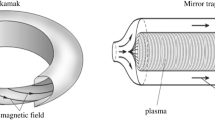Abstract
We consider the behavior of a plasma bounded in the longitudinal direction by absorbing walls. The model contains charged particles (electrons and ions) moving in the direction of an external magnetic field with two velocity components: longitudinal and transverse. The charged particles are created in pairs by a distributed source. The working model is based on the electrostatic “particles in a cell” method augmented by Emmert's model for a volume source and a model of binary Coulomb particle collisions using the Monte Carlo method. Calculation results are reported for a model with electron-ion collisions and for a collisionless plasma model.
Similar content being viewed by others
References
G. A. Emmert, R. W. Wieland, A. T. Menske, and J. N. Davidson, “Electric sheath and presheath in a collisionless, finite ion temperature plasma,” Phys. Fluids,23, No. 4, 803–812 (1980).
J. T. Scheur and G. A. Emmert, “Sheath and presheath in a collisionlees plasma with a Maxwellian source,” Phys. Fluids,31, No. 12, 3645–3648 (1988).
J. T. Scheur and G. A. Emmert, “A fluid treatment of the plasma presheath for collisionless and collisional plasma,” Phys. Fluids B,B2, No. 2, 445–451 (1990).
R. C. Bissell, P. C. Johnson, and P. C. Stangeby, “A review of models for collisionless one-dimensional plasma flow to a boundary,” Phys. Fluids B,B1, No. 5, 1133–1140 (1989).
L. A. Schwager and C. K. Birdsall, “Collector and source sheaths in a finite ion temperature plasma,” Phys. Fluids B,B2, No. 5, 1057–1068 (1990).
R. J. Procassini, C. K. Birdsall, and E. C. Morse, “A fully kinetic self-consistent particle simulation of the collision-less plasma-sheath region,” Phys. Fluids B,B2, No. 12, 3191–3205 (1990).
R. J. Procassini and C. K. Birdsall, “Particle simulation model of transport in a bounded, Coulomb collisional plasma, part 1,” Phys. Fluids B,B3, No. 8, 1876–1891 (1991).
C. Birdsall and A. Langdon, Plasma Physics and Simulation [Russian translation], Énergoatomizdat, Moscow (1989).
T. Takizuka and H. Abe, “A binary collision model for plasma simulated with particle code,” J. Comput. Phys.,25, No. 3, 205–219 (1977).
V. E. Golant, A. P. Zhilinskii, and I. E. Sakharov, Foundations of Plasma Physics [in Russian], Atomizdat, Moscow (1977).
T. Takizuka, K. Tani, M. Azumi, and K. Shimizu, “Particle simulation of divertor plasma,” J. Nucl. Mater.,128–129, 104–110 (1984).
Additional information
Translated from Chislennye Metody v Matematicheskoi Fizike, Published by Moscow University, Moscow, 1996, pp. 100–109.
Rights and permissions
About this article
Cite this article
Filippychev, D.S. Application of the particle method to simulate one-dimensional bounded plasma with a distributed sources. Comput Math Model 8, 135–143 (1997). https://doi.org/10.1007/BF02405163
Issue Date:
DOI: https://doi.org/10.1007/BF02405163




